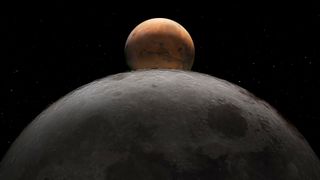NASA maps objectives to guide 'moon to Mars' space exploration
"Moon to Mars Objectives" reveals guiding principles for expansion across the solar system

NASA is working on a blueprint to guide space exploration and infrastructure for the moon, Mars and to destinations across our solar system.
"Our overarching goal is to create a blueprint for sustained human presence and exploration throughout the solar system," NASA deputy administrator Pam Melroy said during a presentation at the International Astronautical Congress 2022 in Paris on Sept. 20.
Melroy was speaking while Artemis 1 sat on the pad back in Florida, with teams working towards a September 27 launch window. She stated that NASA has "hardware all the way through Artemis 4. And even a few things starting for Artemis 5 in work," but the agency is also looking ahead and working on how it will think about and approach exploration in the distant future.
Related: Global space agency leaders see asteroid deflection, moon missions as top priorities
"In the past we have said we will create capabilities and then do whatever those capabilities will enable us to do," Melroy said. "Really, to truly be aspirational and strategic. We have to have objectives. We have to know what the goal is, even if we know we're not fully ready to do everything yet."
"This is very important. It shapes what we're going to do in the future…It's going to become a blueprint, not just for Mars, but for any destination out in the solar system."
NASA released the full list of 63 objectives, drafted following input from NASA's workforce, the public, industry, and the agency's international partners, following Melroy's presentation.
Get the Space.com Newsletter
Breaking space news, the latest updates on rocket launches, skywatching events and more!
The new document fills gaps in a document outlining 50 objectives developed by NASA agency leaders across its mission directorates on areas including transportation, habitation, infrastructure and science for long-term exploration of the solar system released by NASA earlier this year.
The updated objectives document additionally identifies nine tenets, or common themes found to recur across those objectives. These include international and industry collaboration, the safety and time management of crew, maintainability and reuse, and commerce. The latter underlines seeking to foster the expansion of the economic sphere beyond Earth orbit to support U.S. industry and innovation.
"They [the tenets and objectives] will serve as a blueprint for the next two decades or more and they'll be the connective tissue between all of us, between the capabilities between the moon and on to Mars."
Melroy said the architecture and objectives would be revisited each year, with input from workshops.
"Ultimately we're going to need to know how to support humans in deep space. If we're really going to do science and if we're really serious about that, we have to have the infrastructure," Melroy, a former space shuttle commander, said.
Artemis is planned to bring astronauts back to the moon after an absence of more than 50 years, but is also being touted as a stepping stone to Mars.
"That's communications. That's power. That's the ability to use resources in situ, to minimize the logistics training that you have to bring with you every single time you go. We have to have landing pads, navigation and timing all of those things. Very, very critical aspects."
"This is a pretty exciting challenge. We're trying to figure out how to go into the solar system for peaceful scientific exploration. And we need to do it together."
Follow us on Twitter @Spacedotcom or on Facebook.
Join our Space Forums to keep talking space on the latest missions, night sky and more! And if you have a news tip, correction or comment, let us know at: community@space.com.

Andrew is a freelance space journalist with a focus on reporting on China's rapidly growing space sector. He began writing for Space.com in 2019 and writes for SpaceNews, IEEE Spectrum, National Geographic, Sky & Telescope, New Scientist and others. Andrew first caught the space bug when, as a youngster, he saw Voyager images of other worlds in our solar system for the first time. Away from space, Andrew enjoys trail running in the forests of Finland. You can follow him on Twitter @AJ_FI.
